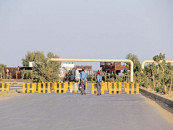The slow downfall of the telecom sector
The govt needs to revise its decisions regarding 3G/4G licensing.

The telecom sector in Pakistan is a major contributor to government revenues. During the last decade, Pakistan has made tremendous progress in the telecom industry because of deregulation and privatisation of the sector. Unfortunately, for the past 3 years, unwarranted complacency and vested interests have arrested rapid growth in the telecom industry.
According to the Economic Survey of Pakistan 2011-12, total investments in the telecom sector stood around $495.8 million in fiscal 2010-11, as compared to $1,137.5 million in fiscal 2009-10. These statistics show that fiscal 2010-11, total investments in the telecom sector fell by 56.4%.
As regards foreign direct investment (FDI), the telecom sector has been a major beneficiary from 2003 to 2009. However, after that period, investments in the telecom sector have declined every year because revenues of cellular operators have diminished owing to tough competition, which has made investors reluctant to contribute additional capital.
If we look into statistics, in fiscal 2010-11 FDI in the telecom sector stood at around $79.1 million; around 5% of total FDI in Pakistan during 2011. In the fiscal year preceding 2010-11, FDI in the telecom sector stood around $374 million; around 17% of total FDI in Pakistan during 2010. These statistics show that total FDI in the telecom sector reduced by 78.9% over FY2010-11.
Besides these facts, total revenues generated by the telecom sector during fiscal 2010-11 were around Rs363 billion: an increase of 5.4% as compared to revenue generated in fiscal 2009-10, which was around Rs344 billion. During the same period, revenue earned by cellular companies rose by 11% to around Rs262.76 billion, as compared to Rs236.05 billion in the previous year.
Due to an increase in revenue generation this year, the telecom sector contributes Rs117 billion in taxes to the national exchequer – the highest ever. But revenue earned by cellular companies is far less as compared to their expenditures on infrastructure, expanding coverage area and services improvement. This is the reason investors are wary of taking any bold decisions as regards investment.
Given the trends, what can the government do to attract foreign investment in telecom? There is only one window of opportunity in sight so far: the auction of 3G and 4G licenses, for which telecom operators and investors have been waiting for over three years now. Unfortunately, due to a lack of political interest, the decision has been postponed yet again.
Pakistan is among the few countries which have yet to adopt the 3G/4G technology. Even countries like Nepal, Sri Lanka and India have already adopted these technologies, which have in turn contributed to positive GDP growth with increasing mobile and internet penetration.
Pakistan is a huge market for mobile telephony and mobile broadband, as the population of Pakistan is growing at exponential rates. For the last four years, there has been tremendous growth in broadband subscribers. According to the Pakistan Telecommunication Authority, broadband penetration will reach 10 subscribers per 100 inhabitants by 2020, and the number of broadband users in Pakistan will touch 78 million.
2G has insufficient utility in fulfilling the demands of services required for agriculture, commerce, health and education sectors. However, 3G technologies have the essential elements for advancing socio-economic development as it will enhance quality of life and provide economic opportunities both in public and private sectors.
The transition from 2G to 3G/4G technology will entail significant economic benefits for Pakistan. Experts in the telecom sector believe that increasing broadband penetration leads to economic gains: a 10% increase in broadband penetration contributes by a percentage in GDP growth, while around 80 new jobs are created for every 1,000 new broadband connections.
According to the International Telecommunication Union, a total of 159 countries around the world are providing broadband and 3G technology services to their populations, while the number of active mobile-broadband subscriptions has exceeded one billion users.
Pakistan must now join the 159 countries that have already adopted 3G/4G technologies. As we already have a well-established 2G infrastructure in Pakistan, 3G/4G can be easily deployed to take broadband access to every nook and corner of the country.
Pakistan cannot afford to delay the process any further. Any further delay in auctioning of 3G/4G licenses will adversely impact this potential sector. The current national IT and telecom policies are outdated and the government must revise its decisions regarding 3G/4G technology and reframe a clear, multidimensional, stakeholder-friendly policy, and also provide an implementation roadmap that can cater for both short-term and long-term objectives.
THE WRITER IS A CONSULTANT AT THE SUSTAINABLE DEVELOPMENT POLICY INSTITUTE.
Published in The Express Tribune, July 9th, 2012.



















COMMENTS
Comments are moderated and generally will be posted if they are on-topic and not abusive.
For more information, please see our Comments FAQ